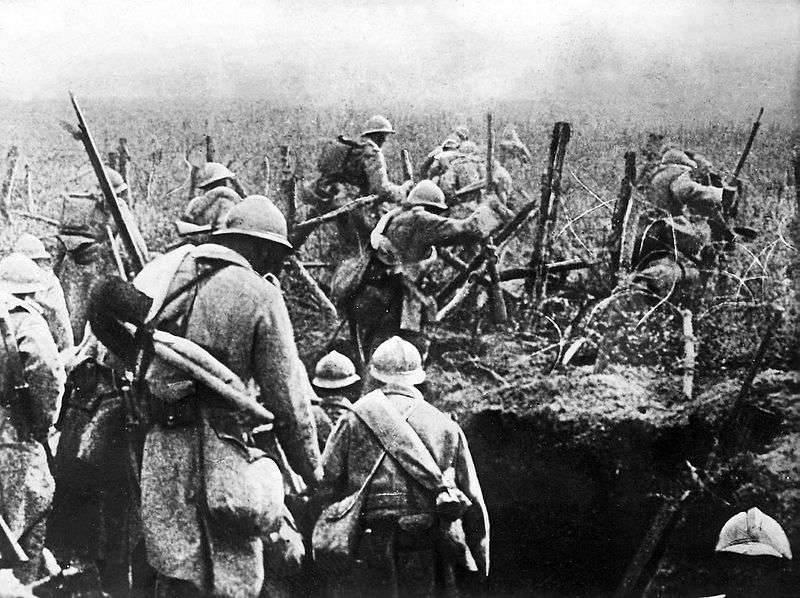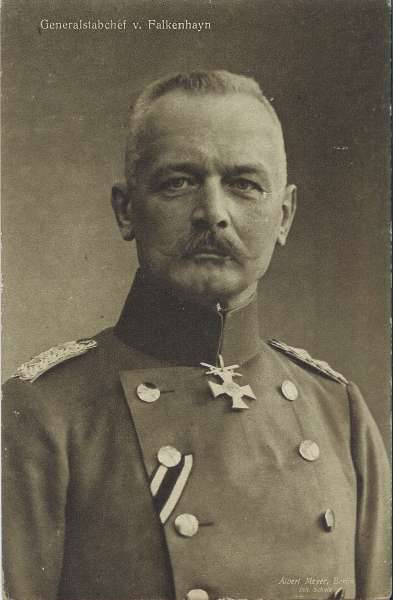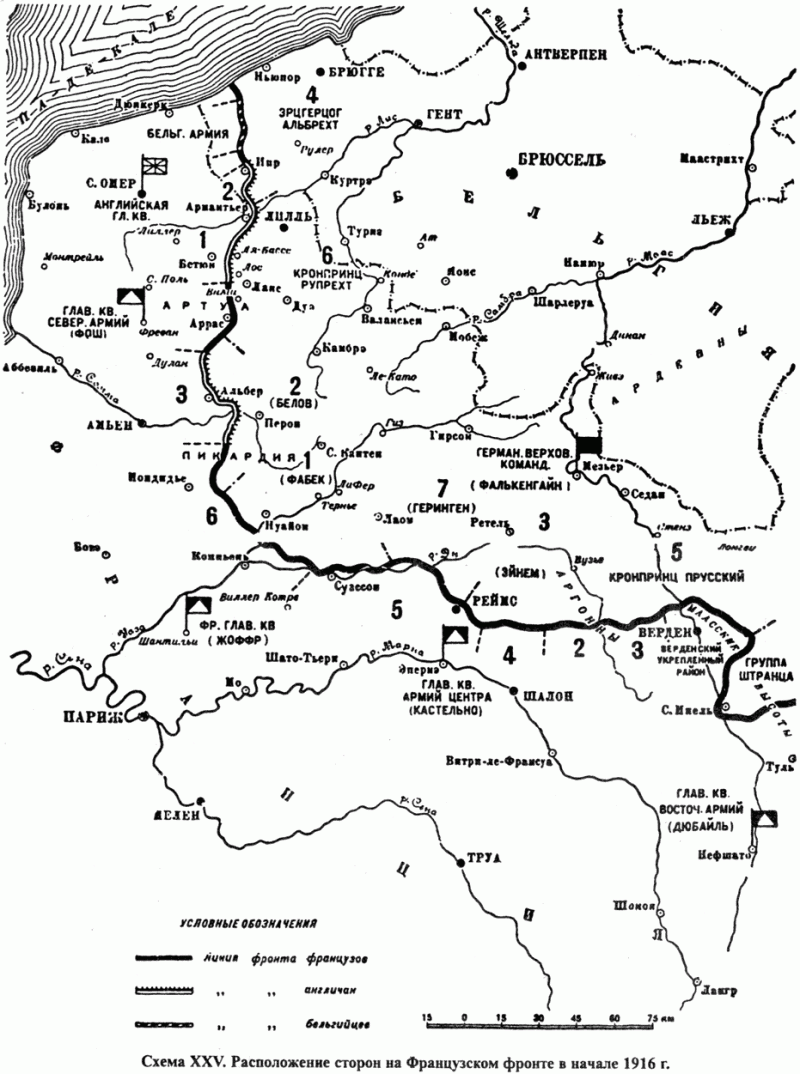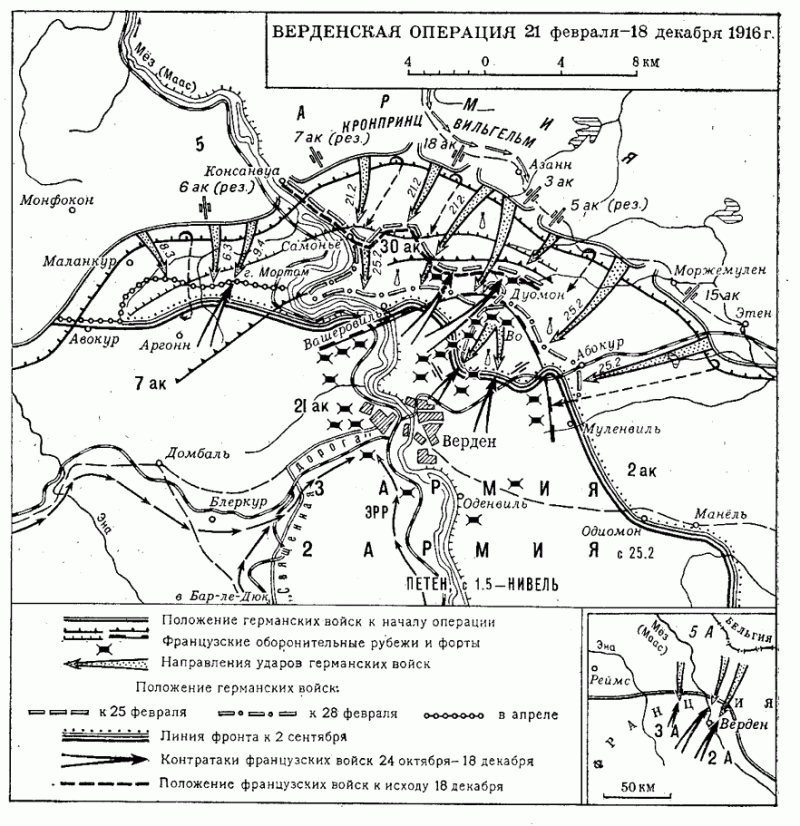Verdun meat grinder

100 years ago, in the second half of February 1916, a big battle began on the Western Front - in the north of France, near the town of Verdun, the German troops launched an offensive. The fierce battles there will continue until the end of 1916, and will enter history as one of the biggest battles of the First World under the name "Verdunsky meat grinder". During the battle of Verdun, both sides lost about a million people, among whom killed - up to 430 thousand people.
February 21 in the morning 7.15 German army delivered a massive artillery strike on the French positions in the area of the city of Verdun. It involved 946 guns, including almost 500 heavy, which focused fire on the entire 5-kilometer front. Hurricane shelling lasted more than 8 hours, the Germans themselves designated it as “Trommelfeuer” - “Hurricane fire”. Then the infantry went on the attack - about 80 thousand people. Scouts and assault groups, consisting of two or three infantry units, reinforced with machine guns and flamethrowers, moved ahead. During the first day of the offensive, the German troops advanced 2 km and occupied the first line of trenches by the French.
The German command planned to break through the enemy front near the town of Verdun, which formed a ledge leading into German positions, surround and destroy several French divisions and open the road to Paris. When developing the operation codenamed “Gericht” (“Justice”), the head of the German General Staff, General Erich von Falkenhayn, took into account the experience of 1915 positional battles of the year. The bet was made on the massive powerful artillery preparation and specially created assault groups. Artillery fire was supposed to break the first line of defense of the French, and attack aircraft - on the shoulders of the retreating French break into the second line of defense.
The French command received in 1915 year reports from intelligence about the possibility of a large German offensive. So, the Germans needed not only to transfer forces to the Verdun area, but also to transfer unnoticed to the French fortified area and a huge amount of artillery, including the giant Burt Bertha millimeter millimeter mortars. The German prisoners were found letters that spoke of the imminent 420 of the German army of the Crown Prince, about the review that the Kaiser would make in late February at the battle site of Verdun, and about the world that would follow after the German victory. However, the inconsistency of intelligence data and the self-confidence of the Allied Command did not allow drawing correct conclusions. As Petain later recalled, “nothing betrayed the feverish activity of the Germans that prevailed in the sector of a future attack,” although the deployment of artillery alone in the intended area of the breakthrough had been going on for a month and a half.
By the end of January, 1916, aerial reconnaissance, had discovered a revival on the railways along the river Meuse. However, the information received was so contradictory that, according to the testimony of French General Petain, "the high command was faced with the question of whether German activity would develop in the east rather than in the west." The Allied Command hoped that Berlin would still conduct the main hostilities on the Russian front, and the revival in the German rear was associated with the transfer of troops to the East. February 10 General Joffre wrote to the British command: "Either the Allies will keep the initiative of action until next summer, or the enemy will launch a powerful attack on the Russians in the spring."
At a meeting of representatives of the Entente countries in Chantilly 14 February, no concerns were expressed about a possible major German offensive, on the contrary, its participants very complacently discussed the possibility of moving themselves to active hostilities on the Western Front not earlier than July 1, and it was planned to launch a future offensive in the river region Somme. This offensive in the West, and, according to the agreements, was to precede the Russian, in order to pull off part of the German forces on the Eastern Front, but even it had to start only on June 15. As a result, the attack near Verdun took the French command by surprise. However, the positions of the allies near Verdun were sufficiently strengthened - the French, given the strategic importance of the fortress, gradually turned it into a fortified area and withstood the first blow.
During the 6 months, German troops almost without interruption stormed the French positions, alternating horrendous artillery shelling, dug square kilometers of land many times, with violent attacks of infantry, when soldiers fought bloody hand-to-hand combat and in trenches without exaggeration. But the French, at the cost of tremendous sacrifices and help from Russia on the Eastern Front, survived, disrupting the plan of the German General Staff to exsanguinate France and force it to an armistice. The Brusilov breakthrough on the Russian front and the operation of the Entente on the Somme forced the German army in the fall of 1916 to go on the defensive, and on October 24, the French troops launched a counteroffensive and by the end of December took up positions that were occupied by the beginning of the battle. The German army significantly undermined its combat potential in this fruitless battle, its fighting spirit was weakened (belief in the coming victory was undermined).
The battle of Verdun entered the world history as one of the brightest symbols of the First World War, becoming the personification of all its horrors. It was not by chance that she was nicknamed “Verdun meat grinder”. In France, Verdun is a sacred place, "the capital of glory" and "a symbol of courage."
General situation on the Western Front
At the beginning of 1916, the entire front in the French theater was divided into two sectors: 1) Anglo-Belgian, from the sea at Newpore to Peron, stretching for about 180 km. He was defended by the 6 Belgian and 39 British divisions. Since the British did not yet feel sufficiently organized and prepared for an independent battle with the Germans, the French held 18 divisions in this sector, of which 4 were in the Belgian army sector and in the British army 14 sector. Against these 63 allied divisions, the Germans had all 30 divisions in the first line and could only support them with 2 reserve divisions.
2) The rest of the front from p. The somme to the Swiss border, which is more than 500 km long, was the French sector. He was defended by the 58 of the French divisions, behind them were still 29 divisions. Against the French sector, the Germans had 70 divisions in the first line and 17 divisions in reserve command.
In order to prepare a general offensive operation on the river. The Somme, the French commander-in-chief, General Joffre, gradually sought to strengthen the British army located in France. The British, having formed the 1915 of the 70 divisions by December, had only about half of their forces in France. The rest of the troops were partly detained in the British Isles, partly sent for combat operations either in colonies, or in secondary theaters of operations, or to Egypt, which was not in serious danger. By March, the British army in France was to increase to 42, by mid-April to 47 and by the end of June to 54 divisions. At the head of the English army, instead of French, General Haig was placed. In the summer, the Allied Command planned to conduct a major offensive operation in the French Theater.
German Command Plans
The head of the German General Staff, Falkenhain (Falkenhayn), from the very beginning of the war considered the French front to be the main one. At the beginning of 1916, France, according to General Falkenhain, both militarily and in socio-economic terms, has already reached its limits. It took a powerful final movement to convince French society of the meaninglessness of further struggle.
Germany could not undertake a general operation on the entire Western Front. The enemy had a strong defense, numerically not inferior, his technical equipment was a little inferior, the morale remained high. Therefore, Falkenhain stopped at a private enterprise - the attack of Verdun to grind the French reserves and make France go to the world.
At the same time, the German command was skeptical about the importance of long-term defense, considering that heavy artillery, applied massively on a limited portion of the front, is capable of "opening the gates" in any defense. The German High Command took into account the experience of the rapid fall of the largest fortresses on the French and Russian fronts during the campaigns of 1914-1915. Heavy German artillery had to crush the Verdun fortifications, not allowing their long-term resistance. Indeed, the fortress, isolated from field defense and field troops, could not hold on for a long time under the blows of heavy artillery.
In addition, the Germans narrowed the front to a minimum. According to Falkenhain, this would allow the attacking infantry to get maximum support from artillery. In fact, the German command did not require a decisive hack of the French defense to its full depth and, accordingly, a breakthrough to Paris — von Falkenhain believed that this goal would not be achieved anyway. German soldiers and officers were only asked to “open the gates, but not enter them,” with the goal of engaging more and more contingents and reserves of the French army in the “Verdun meat grinder”. It was planned to lure the French, who were to go to the counterattack, under the disastrous fire of the German artillery. Create a kind of operational "pump for pumping blood of the French army," so that the French with their bodies try to close the breached gap. The exhaustion of the French army should have forced Paris to seek a political solution.
In fact, von Falkengine’s pessimistic view of the possibility of a decisive overcoming of the main French defensive line and a breakthrough to Paris was the main cause of the senselessness of the colossal victims of the German army at Verdun. The initial strategic deployment of the German army did not involve victory.
It should be noted that Falkengine had an opposition in the German command. A prominent member of the General Staff, General Heinrich von Bauer, believed that the experience of the rapid seizures of the largest Belgian, French and Russian fortresses, such as Liege, Kovno and Novogeorgievsk, testifies to the effectiveness of massive, territorially significantly broader operational coverage. Bauer suggested that the strategic goal of the Verdun operation was not a “meat grinder” for the exhaustion of the French army (which led to the exhaustion of the German army), but a quick, within one to two weeks, seizure of the Verdun fortress. To this end, the breakthrough front had to be substantially increased: the blow from the north had not to be limited to the right bank of the Meuse, but to develop it simultaneously on the 22 front kilometer on both sides of this river. However, the proposal of General Bauer did not receive support. This was apparently the main prerequisite for the strategic failure of the German army at Verdun.

Chief of the General Staff of Germany (1914 — 1916) during the First World War Erich von Falkengine
Preparation of the operation. Forces of the german army
From the beginning of January, 1916 was preparing for the Verdun operation, which, according to the original plan, was to be completed by February 12. Assigned to the shock group 5 of the German Army 7-th Reserve, 18-th and 3-th army corps gradually, starting from the end of 1915, were removed from various sectors of the front and brought to the deep reserves of the Supreme High Command for staffing and training in special camps .
The transport of these troops to the Verdun area, as well as an enormous amount of heavy and heavy artillery, engineering troops and ammunition, was completed by the beginning of February 1916. It was carried out with measures of exceptional camouflage and secrecy. Against the 20-kilometer section of serf positions chosen for the assault on the front of the 5 German reserve corps (from Konsanvua on the Meuse to Orne), nothing outwardly changed. Therefore, initially the French did not find signs of preparing a large local operation with strategic objectives.
The entire breakthrough divisions 8 and 542 heavy (of which 27 were of high power) and 306 field guns and howitzers to assault the assault force were concentrated on the breakthrough site. The artillery group, which provided the auxiliary attack of the 15 corps, consisted of 60 heavy and 136 field guns. The 6 th reserve corps, designed to operate on the left bank of the Maas, was supported by a group of 101 heavy and 80 field guns.
The artillery grouping in 1225 of guns, which was promptly and covertly deployed on the front of the strike group, was further strengthened by 22 heavy, 74 medium and 56 light mortars. The artillery of each of the shock corps was combined into special groups A, B, and C. Groups were assigned to observe and correct the firing of the aeronautic detachment and the 2 detachment of the aircraft 3-1. In total, 168 combat and correction aircraft and 14 aerostats were involved in the operation.
The German command was counting on the success of its artillery preparation. The order of the 5 Army Command from January 4 to prepare for the operation said: “The decision to seize the fortress of Verdun in an accelerated way is based on the tested power of heavy and high-powered artillery.” In addition to artillery, the shock corps were reinforced on average by one pioneer (sapper) regiment for each attacking division and equipped with a large number of blasting means and hand grenades.
Thus, the German command launched a strike group of 5 of the German army of Crown Prince Wilhelm from three corps (7, 18 and 3) to take control of Verdun by an accelerated attack, changing the 5 body to 15-kilometer from p. Maas to Gremili. 5-th reserve corps ottyanuli on the left flank of the strike group. The 15 body, intended for auxiliary strike, was deployed on the left flank of the 5 body.
German corps were deployed as follows:
- The 7 th reserve corps (14-I and 13-I divisions) occupied the 8-kilometer stretch from the river. Maas to Flabasa, having on the left flank the 13-th reserve division at the front in 1 km. The attack of the corps was supported by the artillery of the group A as part of the 156 light and 238 heavy guns and howitzers (of which 60 21-see mortars).
- The 18 Corps (21 and 25 Divisions) deployed on the 2 1 / 2-kilometer front from Flabas to Wil-devans-Chaumont. The corps was supported by an artillery group B of 124 light and 90 heavy guns. In addition, high power 48 21-cm mortars and 4 42-cm mortars, i.e. on average 1 km 110 guns (of which 36 are heavy and 20 are big power).
- The 3 Corps (5 and 6 Divisions) occupied the 5-kilometer section from Ville-devan-Chomon to Gremmili, having a division on the right flank of the 5-km in 1 km. The supporting corps artillery group C consisted of 124 light and 118 heavy guns. In addition, high power 28 21-cm mortars and 16 38- and 42-cm mortars and howitzers, that is, on average, 1 km of 57 front guns, including 35 heavy and high power.
The immediate task of the shock corps was in the capture of the first and second French positions and in the development of the attack on Fort Duomon and in the interval between the last on the r. Maas. 5-th reserve corps did not participate in the offensive and had to chain the enemy. The 15 Corps delivered an auxiliary strike with the support of 60 light and 136 heavy guns to develop the success of the strike force.
Thus, in the first days of the 6½ German divisions (60 battalions) were to break through the location of the 2 reinforced French divisions (72 and 51), the entire 30 battalions. The plan of the German command consisted in the rapid breakthrough of 3 corps on a narrow 8,5-kilometer stretch and in the subsequent mastery of the line of the Duomon and Vaud forts.
In general, the Germans created superiority over the French in the direction of the main blow to the number of divisions in four and in artillery more than four times. In view of the mortars, superiority in artillery increased to 5,5 times. The concentration of so many artillery and mortars in the offensive was made in the war for the first time. For the first time under Verdun flamethrowers were also used. Engineering units were widely used. Each battalion was reinforced by one sapper, and the infantry brigade - by a flamethrower company. A total of the shock corps were attached to 39 engineering and 8 flamethrower mouths. The divisions were supplied with plenty of explosives and hand grenades. It is also worth noting that all sides of the Verdun battle both sides, but with special intensity the Germans, used poison gases - both with the help of usual “balloon” attacks, and with the help of chemical projectiles.
In order to achieve surprise, preparation for the operation was conducted secretly. The German command abandoned the equipment of the original bridgehead - the trenches for the attack in the immediate vicinity of the enemy (100-150 m), as the French did in 1915. th reserve corps. It was believed that the distance in 5-1 km from the initial position to the objects of attack the advancing troops could successfully overcome under the cover of powerful artillery fire. In the initial position, the trenches were prepared for the attacking troops, as well as communications, shelters (adits), firing positions were built, old ones were developed and new access roads were created. Roads were built at the rate of one per division. In addition to field roads, narrow-gauge railways were equipped. 1,5 military workers and 26 rail companies with a total of up to 20 thousand people were involved in preparing the road network. On these roads, by the beginning of the offensive, 20 full trains of artillery shells were brought up. On the basis of 213 shots for field guns, 3000 for field howitzer and 2100 shots for heavy howitzer batteries, these stocks were supposed to provide artillery for the first six days of the battle. Subsequently, it was envisaged to bring 1200 33 / 3 trains of ammunition per day.
For the purpose of difficulty aviation enemy reconnaissance was organized air barrage. In order to divert attention from the preparations for the operation unfolding on the 5th Army’s site, the other German armies of the Western Front were tasked with chasing the enemy in small demonstrative operations on their sections (Arras, Champagne, etc.).
From the areas of concentration (in 15 - 20 km from the front line), the troops were withdrawn to their initial position two days before the beginning of the offensive. Verdun's attack was scheduled for February 12. But due to bad weather (rain, snow, fog) it was postponed from day to day until 21 in February 1916.
To be continued ...
- Alexander Samsonov
- 1916 Campaign
The strategy of the Entente and the Central Powers on 1916 year
"The French Armed Forces will bleed to death in any case - will she keep Verdun or not"
France and England were going to "fight to the last Russian soldier"
Russian soldiers in France
Brilliant victory of the Russian Caucasian army under Erzerum
Keprikeyskoe battle
Assault Erzerum
Defeat of the Turkish Army 3
Trapezund operation


Information